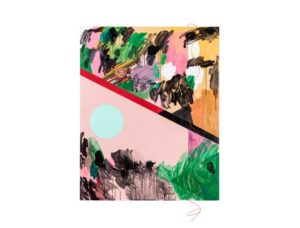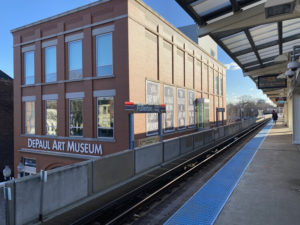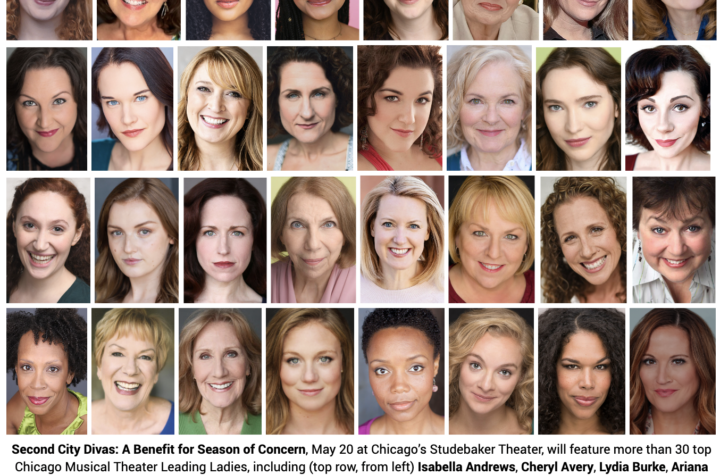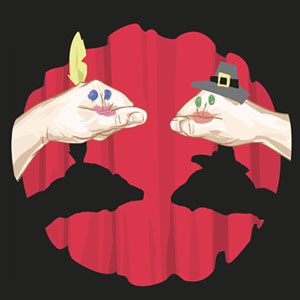
 Love and light overcome darkness in Ayanah Moor’s paintings in the collection of her work entitled “I Wish I Could Be You More Often” at the Cleve Carney Museum of Art, at the College of DuPage. The African-American artist goes inside herself to discover the roots of what it means to be black and especially a black woman. Moor uses bold color, diagonals, collage, and abstraction to demonstrate the positive and negative elements that have made up the emotional centers of her life. In moving from one painting to the next, year by year, we can notice the progression of her inner world. We witness the transition from a world collapsing in on itself to one that evokes possibility. Over time, she has become more optimistic about life and has learned to accept herself for the person she is, not the person that she may have represented to others. This is a very soul-searching exhibition, for we see the artist evolve as she breaks free of other people’s expectations of who or what she should be.
Love and light overcome darkness in Ayanah Moor’s paintings in the collection of her work entitled “I Wish I Could Be You More Often” at the Cleve Carney Museum of Art, at the College of DuPage. The African-American artist goes inside herself to discover the roots of what it means to be black and especially a black woman. Moor uses bold color, diagonals, collage, and abstraction to demonstrate the positive and negative elements that have made up the emotional centers of her life. In moving from one painting to the next, year by year, we can notice the progression of her inner world. We witness the transition from a world collapsing in on itself to one that evokes possibility. Over time, she has become more optimistic about life and has learned to accept herself for the person she is, not the person that she may have represented to others. This is a very soul-searching exhibition, for we see the artist evolve as she breaks free of other people’s expectations of who or what she should be.
One of the most significant paintings is one of the early works in this exhibition. Armstead & Marina (2016) is based on an actual photograph that the artist took in 1997 of a slave cabin during a visit to a North Carolina plantation. This was a humble place where Moor’s ancestors once lived when they were slaves, a place that still exists today. The photo simultaneously evokes both the emotions of “home” and “horror”, and the finished painting is a play of opposites. The artist does not want to forget the love that would have been present in this slave cabin among family members, while simultaneously she is reviled by the oppression of her ancestors. Brutality would have surrounded the family that lived there.
Moor’s abstraction of a concrete place evokes a sentiment that becomes ever more present in her subsequent paintings that tend to be much more abstract. It is only after her feeling of being choked by the outside world that she is forced to look inside herself and discover who she really is. In “Before and After”, the question is cultural: Before or after what? We see the change in the woman’s makeup and hair. And is one better or worse than the other? And why? “As black people, we deal with projections onto us,” said Moor, during the forty-minute artist discussion. And as a black woman, she asks herself, “Who is defining and redefining me in the mainstream (white) world? Whose history or culture am I being defined by? And who do I identify with and why?
Hence we come to the title of the show: “I Wish I Could Be You More Often.” What does the “you” mean? Does it refer to adopting the white society’s standards and culture? Or does the “you” refer to becoming yourself or learning to become yourself, namely, the person you need to be? The shift in the meaning of the word “you” is the secret behind this whole exhibition.
In the end, blackness, or what it means to be black in America, is turned on its head. Rather than it being defined by others, it becomes a matter of how you define it for yourself. Once this realization is made, it is only then that you can break free of other people’s expectations and become yourself. In the artist’s discussion, it was hinted at that this evolution is not necessarily an experience that she would wish on others: From the get-go, we should all be free to be ourselves. Free to love whoever we wish. Free to practice what it means to love in keeping with the multiple ways that love can be defined. The bottom line is to “Love Thyself” and be true to yourself and your inner voice, whoever you are!
My guest was an artist trained at the Art Institute, who was very taken by Moor’s paintings. Among her observations, she noticed that one of the panels listed in the program guide was apparently hanging upside down, because it didn’t match up with what was on page 5. She pointed this out to curator and director Justin Witte, who took the original painting off the wall. It was then that we realized that the mistake was in the printed copy, where the image had accidentally been rotated 180 degrees. If you come to the exhibition, you can see this for yourself! But that shouldn’t be your only reason to visit. The use of shape, color, and design in Moor’s artwork is striking and significant. You don’t have to be black or a member of a minority group to enjoy this exhibition or understand its deeper meaning. It is impactful and very interesting—and a great way to spend a portion of your afternoon.
“I Wish I Could Be You More Often” is on display at the Cleve Carney Museum of Art (CCMA), at the College of DuPage, MacAninch Arts Center, 425 Fawell Blvd., in Glen Ellyn, Illinois, through April 10, 2022.
Park in lot Fawell A.
The exhibition is free and unticketed. Gift shop is open during museum hours.
Museum Hours: Wednesday through Sunday: 11:00 a.m. – 5:00 p.m.
and 1 hour before and during the intermission of performances in the Belushi Performance Hall.
There will be an artist talk on Tuesday, March 22 at 11:00 a.m. at the CCMA (an event that was originally scheduled for February 17th, but postponed because of COVID).
Accessibility: Elevators in the McAninch Arts Center are located inside and to the right of the main entrance.
For more information about the exhibition, please go to: https://www.theccma.org/ayanah-moor.
For information about the MacAninch Arts Center and for directions on how to get to the show, go to: https://www.atthemac.org/plan-your-visit/.
For additional information, phone 630-942-2321 or email info@theccma.org.
With the sunsetting of COVID restrictions, note that masks are currently optional at the MacAninch Arts Center. On Monday, March 14 all COVID vaccination screening and masking requirements will end.






More Stories
“The Prom” at Glenbrook High School
“The Simon & Garfunkel Story” comes to Chicago
Passover Dinner at Frank’s ( Italian style)